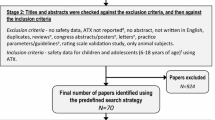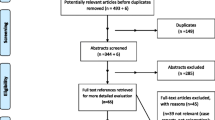Abstract
Objective: This study describes and assesses potential hepatobiliary events related to atomoxetine therapy, as reported in clinical trials and as spontaneous adverse event reports post-launch in 2002.
Methods: Case reports that contained potential hepatobiliary events were identified by a computerized search of the Eli Lilly and Company atomoxetine spontaneous adverse events and clinical trials databases. All cases were reviewed by at least two company physicians, one with expertise in hepatology, to determine the relevance of the information in respect of potential liver toxicity.
Results: Of 7961 paediatric and adult patients treated with atomoxetine in clinical trials, 41 were identified as having hepatobiliary events requiring additional analysis. Most of these events were mild increases in ALT and AST levels. None of these cases met Hy’s rule criteria or progressed to liver failure. During the 4 years after market launch, 351 spontaneous reports of adverse events were related to the liver, of which 69 had other explanations unrelated to atomoxetine. Of the remaining 282 cases, 133 contained possible confounding factors (and were deemed to be possibly related), 146 presented too little information to assess, and three suggested atomoxetine as a probable cause of liver injuries. One of the three had a positive rechallenge. All three patients recovered after discontinuation of the drug.
Conclusions: Since the launch of atomoxetine therapy, three spontaneously reported cases of reversible drug-induced liver injury were deemed probably related to it. Atomoxetine should be discontinued in patients with jaundice or laboratory evidence of liver injury and should not be restarted.






Similar content being viewed by others
References
Ostapowicz G, Fontana RJ, Schiodt FV, et al. Results of a prospective study of acute liver failure at 17 tertiary care centers in the United States. Ann Int Med 2002 Dec 17; 137(12): 947–54
Navarro VJ, Senior JR. Drug-related hepatotoxicity. N Engl J Med 2006; 354: 731–9
Lee WM. Drug-induced hepatotoxicity. N Engl J Med 2003; 349: 474–85
Bymaster FP, Katner J, Nelson DL, et al. Atomoxetine increases extracellular levels of norepinephrine and dopamine in prefrontal cortex of rat: a potential mechanism for efficacy in attention deficit/hyperactivity disorder. Neuropsychopharmacology 2002 Nov; 27(5): 699–711
Kratochvil CJ, Vaughan BS, Harrington MJ, et al. Atomoxetine: a selective noradrenaline reuptake inhibitor for the treatment of attention-deficit/hyperactivity disorder. Expert Opin Pharmacother 2003 Jul; 4(7): 1165–74
Swanson CJ, Perry KW, Koch-Krueger S, et al. Effect of the attention deficit/hyperactivity disorder drug atomoxetine on extracellular concentrations of norepinephrine and dopamine in several brain regions of the rat. Neuropharmacology 2006; 50(6): 755–60
Eli Lilly and Company. Strattera package insert]. Indianapolis (IN): Eli Lilly and Company, 20
Sauer JM, Ring BJ, Witcher JW. Clinical pharmacokinetics of atomoxetine. Clin Pharmacokinet 2005; 44(6): 571–90
Wernicke JF, Kratochvil CJ. Safety profile of atomoxetine in the treatment of children and adolescents with ADHD. J Clin Psychiatr 2002; 63 (Suppl. 12): 50–5
Michelson D, Adler L, Spencer T, et al. Atomoxetine in adults with ADHD: two randomized, placebo-controlled studies. Biol Psychiatry 2003 Jan 15; 53(2): 112–20
Bangs ME, Hazell P, Danckaerts M, et al. on behalf of the Atomoxetine ADHD/ODD Study Group. Atomoxetine for the treatment of attention-deficit/hyperactivity disorder and oppositional defiant disorder. Pediatrics 2008; 121(2): e314–20
Gau SS, Huang YS, Soong WT, et al. A randomized, double-blind, placebo-controlled clinical trial on once-daily atomoxetine in Taiwanese children and adolescents with attention-deficit/hyperactivity disorder. J Child Adolesc Psychopharmacol 2007; 17(4): 447–460
Bangs ME, Emslie GJ, Spencer TJ, et al. on behalf of the Atomoxetine ADHD and Comorbid MDD Study Group. Efficacy 354 and safety of atomoxetine in adolescents with attention-deficit/hyperactivity disorder and major depression. J Child Adolesc Psychopharmacol 2007; 17(4): 407–20
Kratochvil CJ, Michelson D, Newcorn JH, et al. High-dose atomoxetine treatment of ADHD in youths with limited response to standard doses. J Am Acad Child Adolesc Psychiatry 2007; 46(9): 1128–37
Geller D, Donnelly C, Lopez F, et al. Atomoxetine treatment for pediatric patients with attention-deficit/hyperactivity disorder with comorbid anxiety disorder. J Am Acad Child Adolesc Psychiatry 2007; 46(9): 1119–27
Wang Y, Zheng Y, Du Y, et al. Atomoxetine versus methylphenidate in paediatric outpatients with attention deficit hyperactivity disorder: a randomized, double-blind comparison trial. Aust N Z J Psychiatry 2007; 41(3): 322–30
Prasad S, Harpin V, Poole L, et al. on behalf of the SUNBEAM Study Group. A multi-centre, randomized, open-label study of atomoxetine compared with standard current therapy in UK children and adolescents with attention-deficit/hyperactivity disorder (ADHD). Curr Med Res Opin 2006; 23(2): 379–94
Adler LA, Sutton VK, Moore RJ, et al. Quality of life assessment in adult patients with attention-deficit/hyperactivity disorder treated with atomoxetine. J Clin Psychopharmacol 2006; 26(6): 648–52
Michelson D, Faries D, Wernicke J, et al. Atomoxetine in the treatment of children and adolescents with attention-deficit/ hyperactivity disorder: a randomized, placebo-controlled, dose-response study. Pediatrics 2001 Nov; 108(5): e83
Spencer TJ, Heiligenstein JH, Biederman J, et al. Results from 2 proof-of-concept, placebo-controlled studies of atomoxetine in children with attention-deficit/hyperactivity disorder. J Clin Psychiatry 2002 Dec; 63(12): 1140–7
Michelson D, Allen AJ, Busner J, et al. Once-daily atomoxetine treatment for children and adolescents with attention deficit hyperactivity disorder: a randomized, placebo-controlled study. Am J Psychiatry 2002 Nov; 159(11): 1896–901
Kelsey DK, Sumner CR, Casat CD, et al. Once-daily atomoxetine treatment for children with attention-deficit/hyperactivity disorder, including an assessment of evening and morning behavior: a double-blind, placebo-controlled trial. Pediatrics 2004 Jul; 114(1): e1–8
Weiss M, Tannock R, Kratochvil C, et al. A randomized, placebo-controlled study of once-daily atomoxetine in the school setting in children with ADHD. J Am Acad Child Adolesc Psychiatry 2005 Jun; 44(7): 647–55
Allen AJ, Kurlan RM, Gilbert DL, et al. Atomoxetine treatment in children and adolescents with ADHD and comorbid tic disorders. Neurology 2005; 65: 1941–9
Lim JR, Faught PR, Chalasani NP, et al. Severe liver injury after initiating therapy with atomoxetine in two children. J Pediatr 2006; 148: 831–4
Stojanovski SD, Casavant MJ, Mousa HM, et al. Atomoxetine-induced hepatitis in a child. Clin Toxicol 2007; 45(1): 51–5
Kratochvil CJ, Wilens TE, Greenhill LL, et al. Effects of long-term atomoxetine treatment for young children with attention-deficit/hyperactivity disorder. J Am Acad Child Adolesc Psychiatry 2006; 45(8): 919–27
Wilens TE, Newcorn JH, Kratochvil CJ, et al. Long-term atomoxetine treatment in adolescents with attention-deficit/ hyperactivity disorder. J Pediatr 2006; 149(1): 112–9
Wilens TE, Kratochvil C, Newcorn JH, et al. Do children and adolescents with ADHD respond differently to atomoxetine? J Am Acad Child Adolesc Psychiatry 2006; 45(2): 149–57
PhRMA/FDA/AASLD. Drug-induced hepatotoxicity. US Food and Drug Administration 2000; FDA White Paper: 1–29
Temple RJ. Hepatotoxicity through the years: impact on the FDA online]. Available from URL: http://www.fda.gov/cder/livertox/Presentations/im1389/ Accessed 2008 Feb 21]
Danan G, Benichou C. Causality assessment of adverse reactions to drugs: I. A novel method based on the conclusions of international consensus meetings: application to drug-induced liver injuries. J Clin Epidemiol 1993; 46(11): 1323–30
Sgro C, Clinard F, Ouazir K, et al. Incidence of drug-induced hepatic injuries: a French population-based study. Hepatology 2002 Aug; 36(2): 451–5
Ibanez L, Perez E, Vidal X, et al. Prospective surveillance of acute serious liver disease unrelated to infectious, obstructive, or metabolic diseases: epidemiological and clinical features, and exposure to drugs. J Hepatol 2002 Nov; 37(5): 592–600
Duh MS, Walker AM, Kronlund KH. Descriptive epidemiology of acute liver enzyme abnormalities in the general population of central Massachusetts. Pharmacoepidemiol Drug Saf 1999 Jul; 8(4): 275–83
US Food and Drug Administration. New warning for Strattera online]. Available from URL: http://www.fda.gov/bbs/topics/ANSWERS/2004/ANS01335.html Accessed 2007 Aug 3]
Acknowledgements
This work was supported by Eli Lilly and Company, Indianapolis, IN, USA. The authors contributed to the study concept and design; collection, analysis and interpretation of data; preparation of the manuscript; and decision to publish the data. Drs Bangs, Jin, Desaiah, Allen, Regev and Wernicke and Ms Zhang are employees of Eli Lilly and Company and own stock. Dr Holly Read is a former employee of Eli Lilly and Company and owns stock. Dr Read’s current affiliation is Abbott Laboratories.
The authors wish to thank the investigators for their role in the conduct of the trials that contributed data for this manuscript and also to thank the many patients who participated in the trials.
Author information
Authors and Affiliations
Corresponding author
Rights and permissions
About this article
Cite this article
Bangs, M.E., Jin, L., Zhang, S. et al. Hepatic Events Associated with Atomoxetine Treatment for Attention-Deficit Hyperactivity Disorder. Drug-Safety 31, 345–354 (2008). https://doi.org/10.2165/00002018-200831040-00008
Published:
Issue Date:
DOI: https://doi.org/10.2165/00002018-200831040-00008




